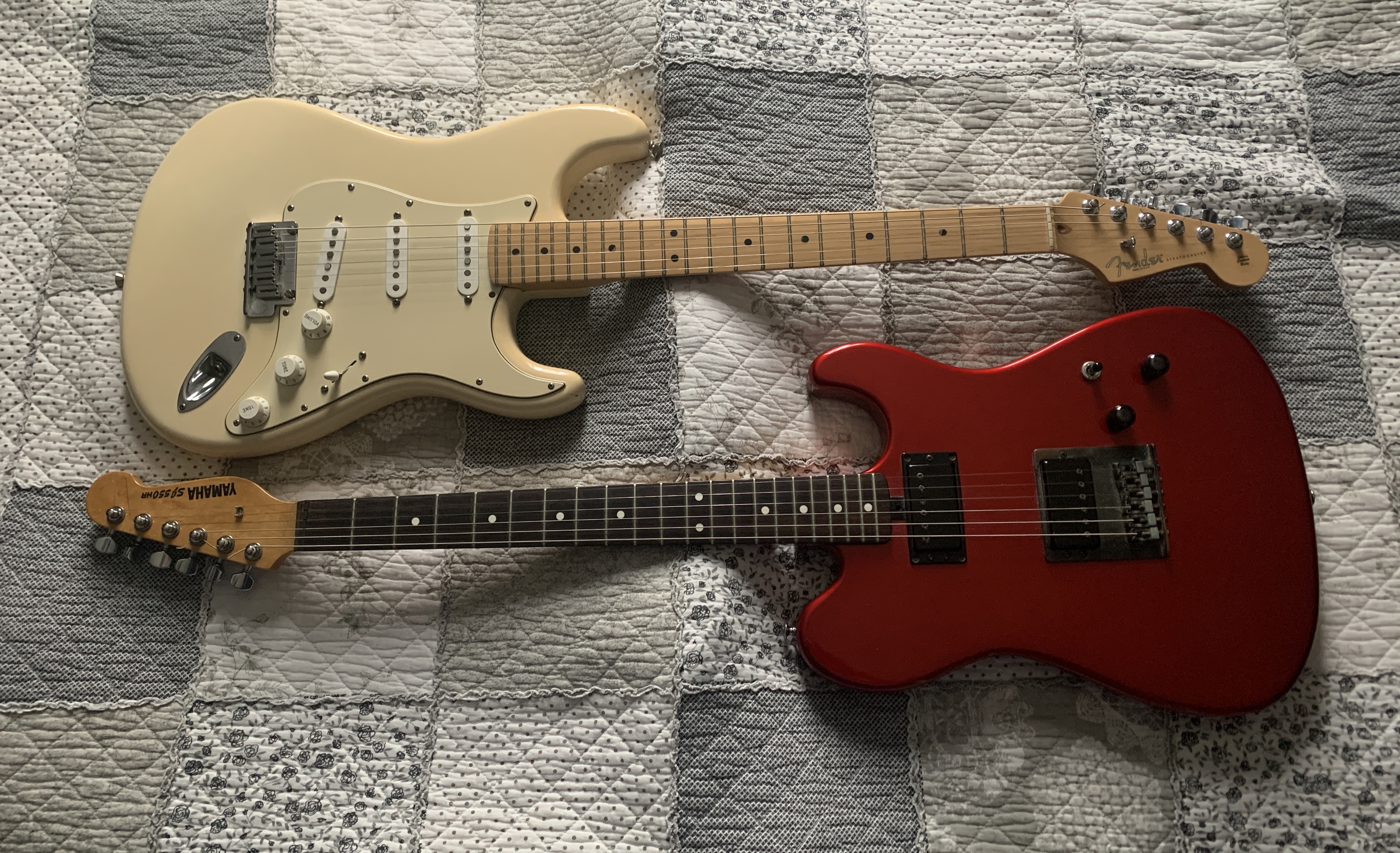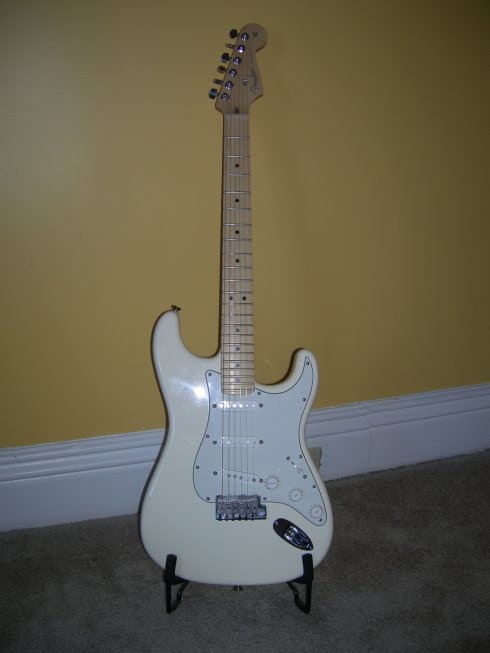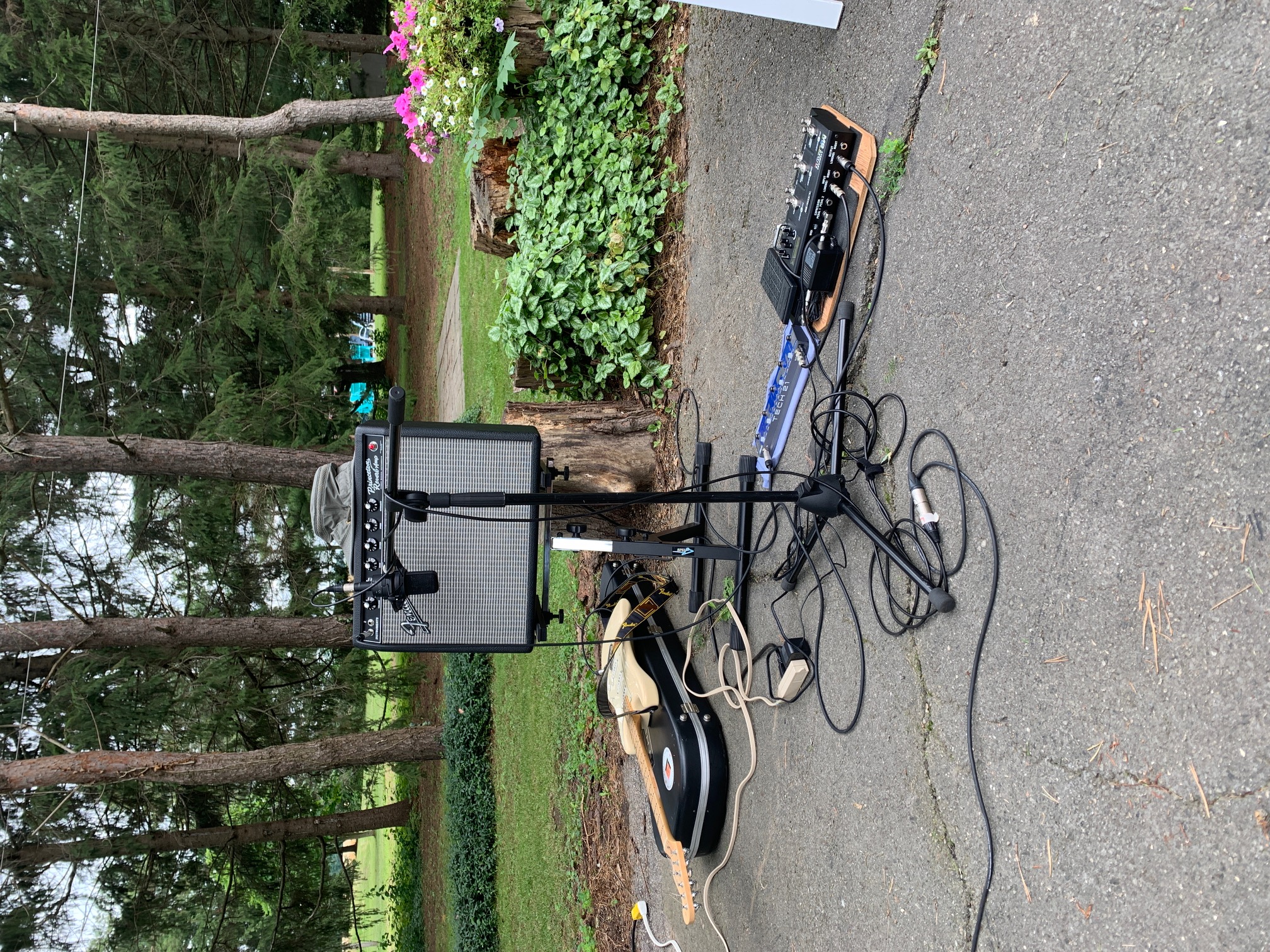My Gear

I am not really a gear hound. I like to keep things simple.
Guitars
Red
One day while walking home from high school I stopped in the London Guitar Shoppe and saw a guitar I absolutely fell in love with. A used Yamaha SJ-550. This was around 1986. I told my dad about the guitar. I believe the next day we went up and he bought it for me. This guitar has been with me ever since and I'll never part with it because of the sentimental value it holds. I used Red all the way through Baku. It is a Tele style guitar with a fixed bridge. It has two tap-able humbucking pickups.

Lynn
I remember distinctly watching the Woodstock movie when I was around 14 and being completely blown away by Jimi Hendrix's performance. On the stage he played an Olympic white Fender Stratocaster with a maple neck. That guitar was the inspiration behind "String Thing #2" and honestly probably propelled me into the life of guitar playing ever since. Strats were it. I never got myself a Strat either because of expense or what have you. When I was 37 I was loaned the book "The Stratocaster Chronicles" which I read cover to cover. It completely renewed my love of Strats. My wife listened as I talked in detail about the guitars and on my 40th birthday she and my son presented me with my own Strat. An American Series Fender Stratocaster with Olympic white body and a maple neck. I named the guitar "Lynn" which is my wife's middle name. This guitar has been my primary guitar ever since.

The Baritone (aka String Thing #2)
This was the first real guitar. It was modeled vaguely on a Fender Stratocaster. I used this during the first few years of Bits Of Food. It had a distinctive sound, bright, thin, and nasally. It was also quite a challenge to play because it had a long scale which puts the frets further apart but my hands are not particularly large and at 16 were even smaller.
I have since updated this guitar to be strung as a baritone (A to A) which really works well. I've also rewired it from its original active electronics to use a passive "full blender" wiring which allows me to blend each pickup into the sound. With the new baritone strings and the new wiring the guitar has taken on a much more pleasing and natural "woody" sound.

Vitals
- Built around 1982
- 7.8 lbs
- 22 frets
- 28 1/2 inches from nut to bridge.
- brass nut
- T-bar re-enforced neck
- two piece guitar made from white oak
- maple fret board
- 3 single coil Fender Strat style pickups wired with "full blender" circuit
Amplifiers
Fender Princeton Reverb
What can I say? I am a Princeton Man. This amp is the sound that I hear in my head. End of story.
Pedal Board

I like having a variety of sounds available but I also appreciate a board that is simple enough for me to carry to a gig. This is my "do everything" board. I use it to record, play at home and play out.
Line 6 M9
A very flexible multi-fx pedal that provides a wide range of different effects. Depending on the situation I use this with or without the expression pedal which is why it is not attached to the board
Primary effects leveraged:
- Reverse Delay
- Auto-volume Delay
- Digital Delay
- Particle Reverb
- Tube Drive
- Pi Fuzz
- Volume Pedal
- Pitch Vibrato
- Script Phaser
Eventide Rose
The latest addition. I like the potential for a long (up to 54 seconds) delay. The reversing delay is cool and the modulation is really nice.
Eventide Black Hole
I am definitely a reverb junky. The Line 6 M9 has solid reverbs that I love and my Princeton has an incredible tube driven spring reverb but I wanted something that was totally otherworldly. The Black Hole has an extremely powerful reverb engine that is easily tweakable.
TC Electronic Ditto X4
I also have the original Ditto. Much of my own recordings start from loops and I like the ability to have two independent loops. I used to bring this along for working with Name With No Sound but with Magic Daffodils there is already a lot of sound so adding loops would be too much.
Recording Gear
My home studio is pretty basic:
- Focusrite Scarlett 2i2 as my audio capture
- Ableton Live Standard as my DAW
- Zoom H2N for live capture and field recordings
- Occasional use of Audacity as a secondary DAW
Other stuff
Firstly I am impressed that you've bothered to read this far. :-)
Homemade Guitars
I have three guitars I've made with some help from my dad when I was younger. These guitars have been mostly retired and I still own #2, #3, and #4. I mostly share this info because it is part of my musical past.
String Thing #1
This was the first attempt at building a stringed instrument for me to play. I remember being mostly disappointed with it because I couldn't get it to sound like an electric guitar.
Vitals
- Built around 1980
- Acrylic plastic nut and bridge
- Fretless bridge pieces could be moved up and down the body
- Wide neck
- This "guitar" was at one point sawed in half and had a hinge inserted in the gap in the misguided attempt to add a tremolo like feature. Eventually laminated back together.
- Deceased. I honestly can't recall what happened to this instrument.
String Thing #2
See baritone guitar above
String Thing #3
This guitar was my main guitar in Bits Of Food. It was a good size for me and was lighter in weight partly in relation to the weight of the earlier guitars. The two humbucking pickups provided a good solid sound and it had a built in compressor for even more boost.

Vitals
- Built around 1983
- 5.8 lbs - lighter to address some of the weight considerations with Guitar 1
- 22 frets 25 inches from nut to bridge. Smaller to address the neck length problems from Guitar 1
- Neck taken from a cannibalized cheap commercial guitar
- Laminated body with pieces of oak, mahogany and some other woods
- One PAF style humbucking pickup at the neck position and one Lawrence pickup at bridge.
- Built in compression electronics
String Thing #4
I can't really remember the origin of this guitar. I believe actually it was more motivated by my dad than anything. We were both fascinated by the Chapman Stick which partially explains the appearance. It was also an attempt to use tremolo which is Fender Stratocaster styled. I have used this guitar mostly in situations where I was playing in one of the noise venues (i.e. with The Nihilist Spasm Band or at the No Music Festivals). It tends to be a good guitar for just wailing on. It is the only one of the guitars I built that has been in active service in the past 20 years.

Vitals
- Built around 1988
- 7.0 lbs - weight increased by artificially attaching a metal plate at the bottom of the guitar to help balance it
- 22 frets
- 24 1/4 inches from nut to bridge
- Gotch machine heads
- Bone nut
- Maple fret board
- One piece mahogany body with a separate piece of wood added later for a strap
- One single coil fender Stratocaster style pickup at neck and One Bartolini pickup at neck position. Bartolini pickup wired to be tapped
- Fender style tremolo system
Other Amplifiers
Roland Cube 30x
A digital modeller. I prefer using the JC Clean, Black Panel, and Tweed models. I mostly used this platform for recording with Name With No Sound as it outputs a good line level signal that can be used into the mixer/recorder.
ZT Lunchbox
When I saw this thing I knew I had to have it. If I was to design an amplifier this would probably have been it. Small, clean, loud with nothing extra. It can be used standalone or as a head. I have used it a number of times for practice with Name With No Sound and performed with it. It is a perfect clean platform for my pedals. I am on a 3rd generation of Lunchbox. The 1st gen box I had originally had a lot of hiss. I contacted the designer at ZT and he agreed to send me a newer one.
Peavey Special 130
Freakishly loud and heavy. My dad and I split the cost of this thing back in the 80's. I used it for almost all the Bits Of Food performances. He used it in The Nihilist Spasm Band. This thing is completely overkill for almost any venue.
